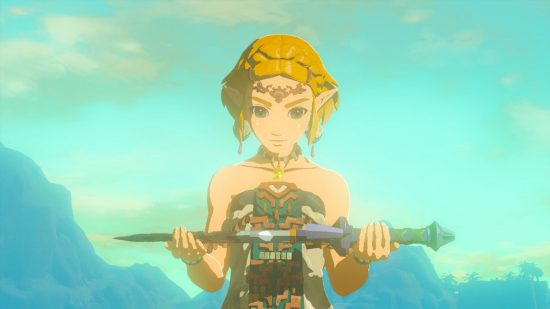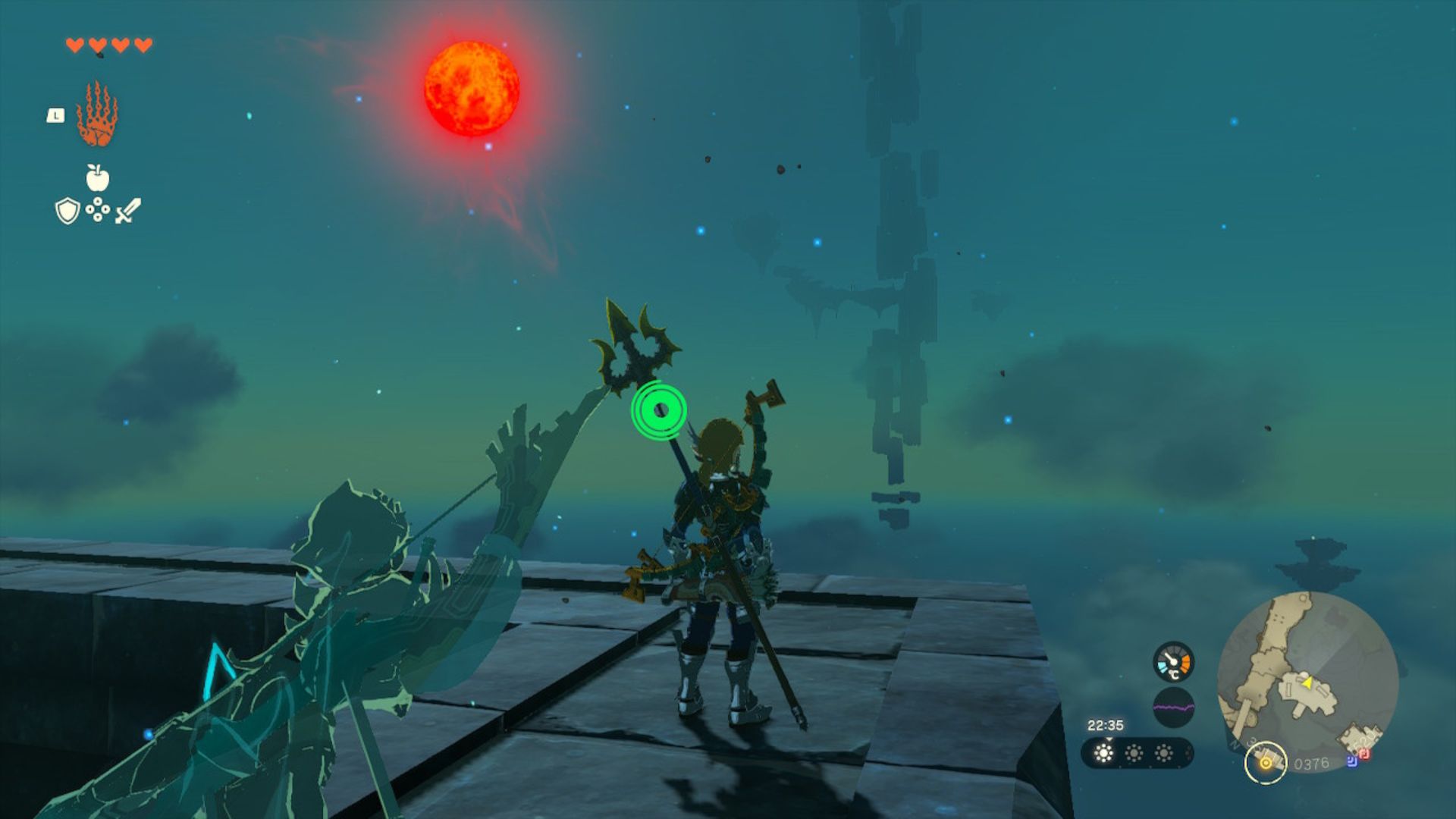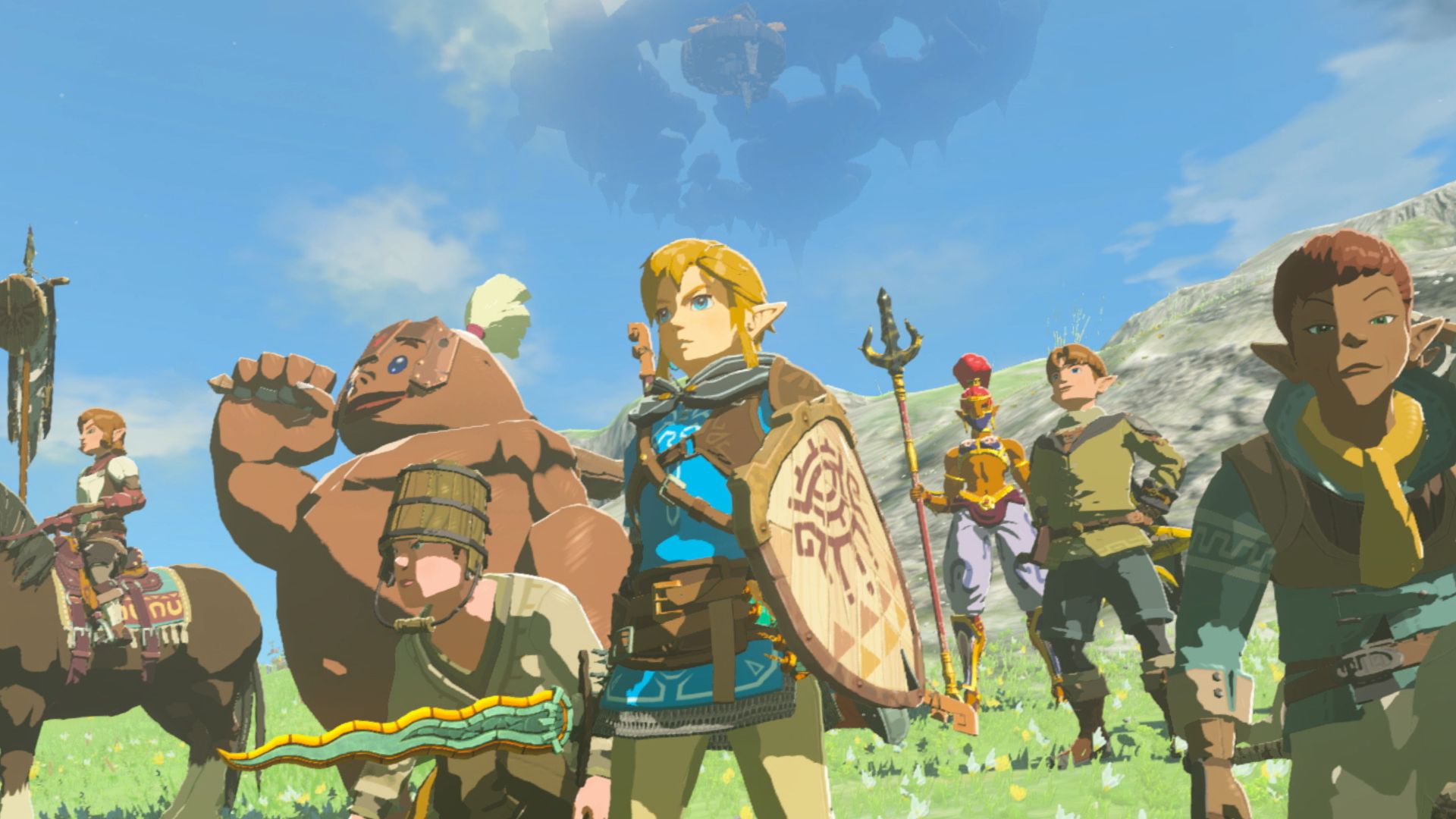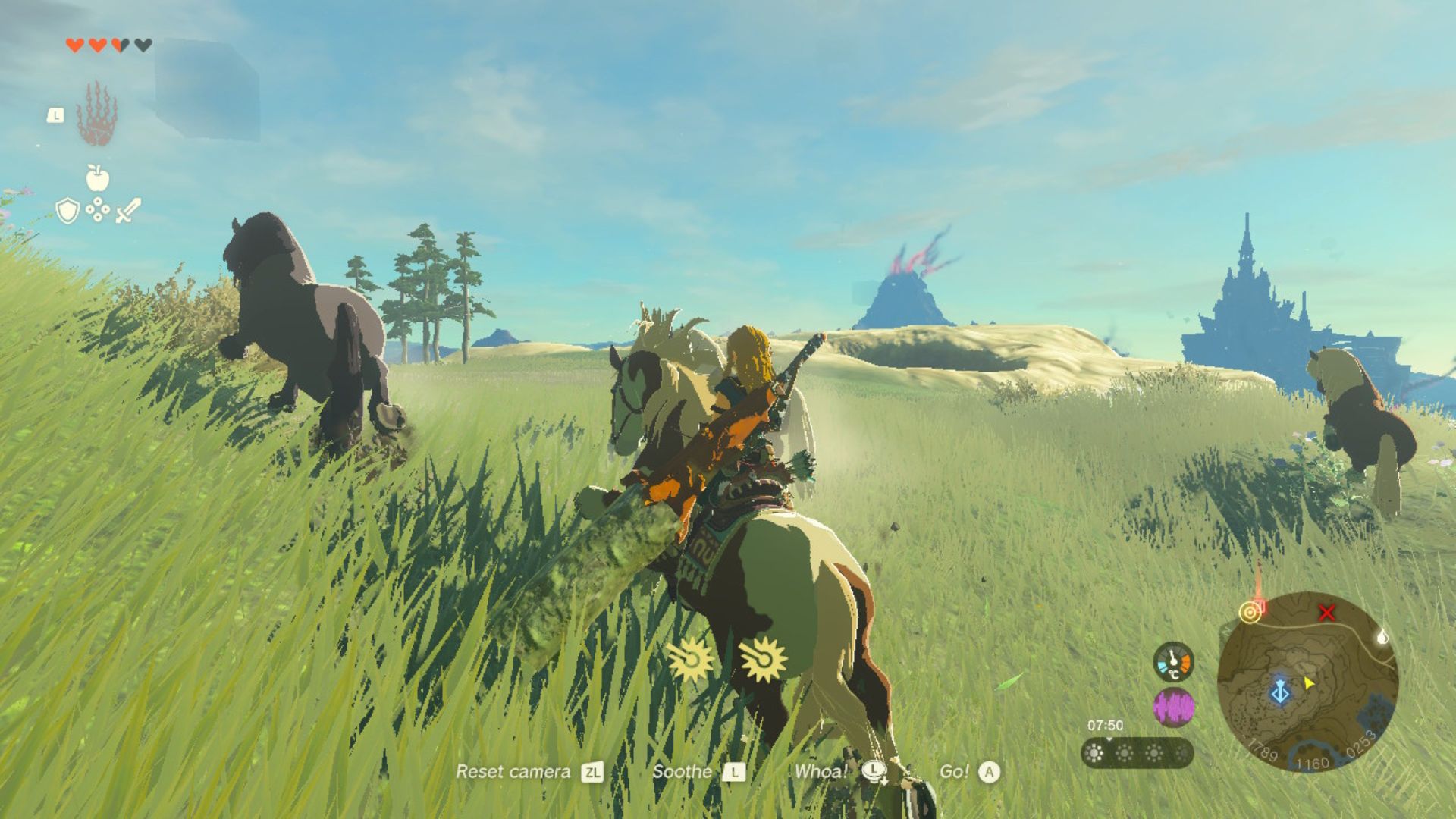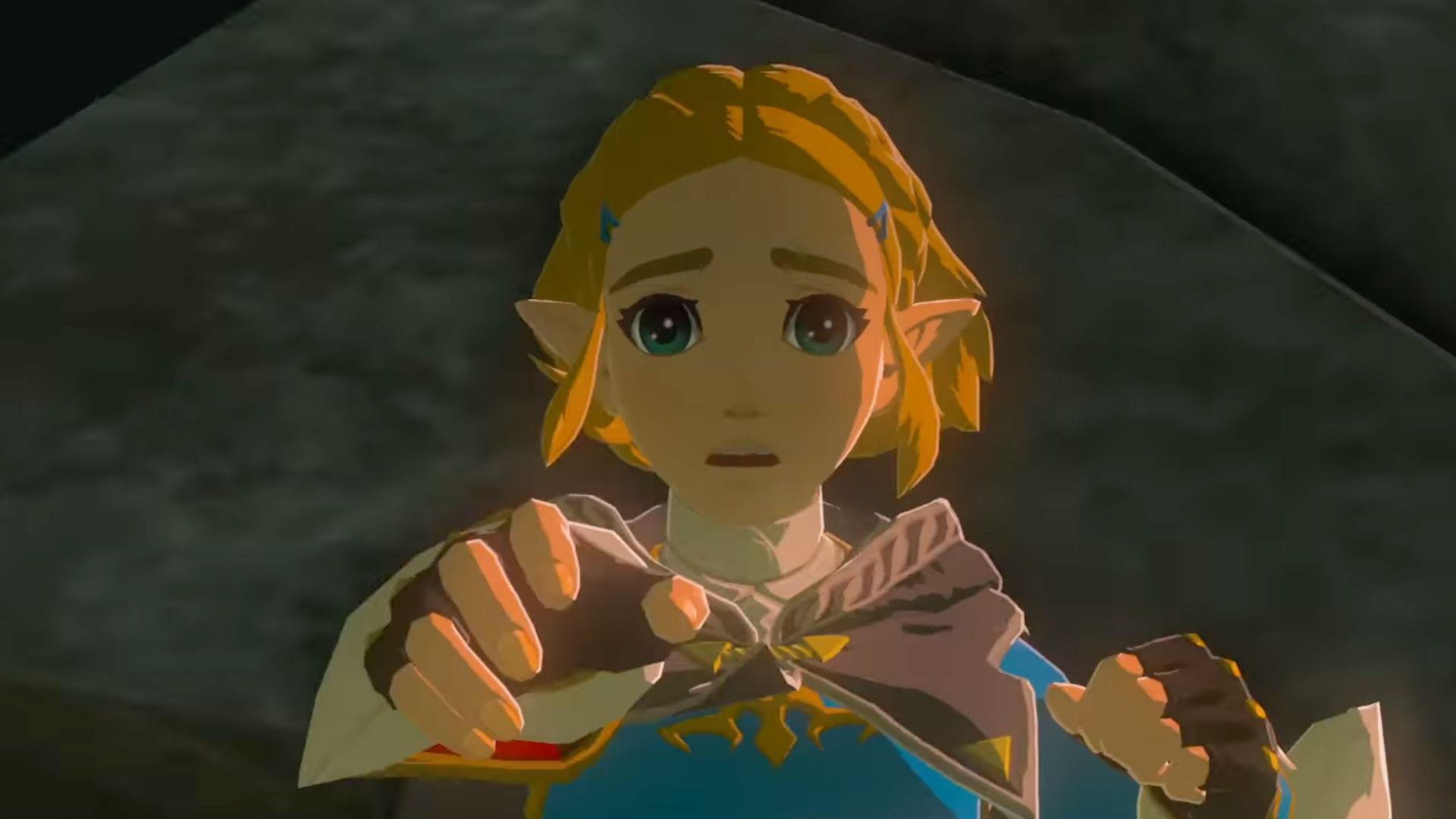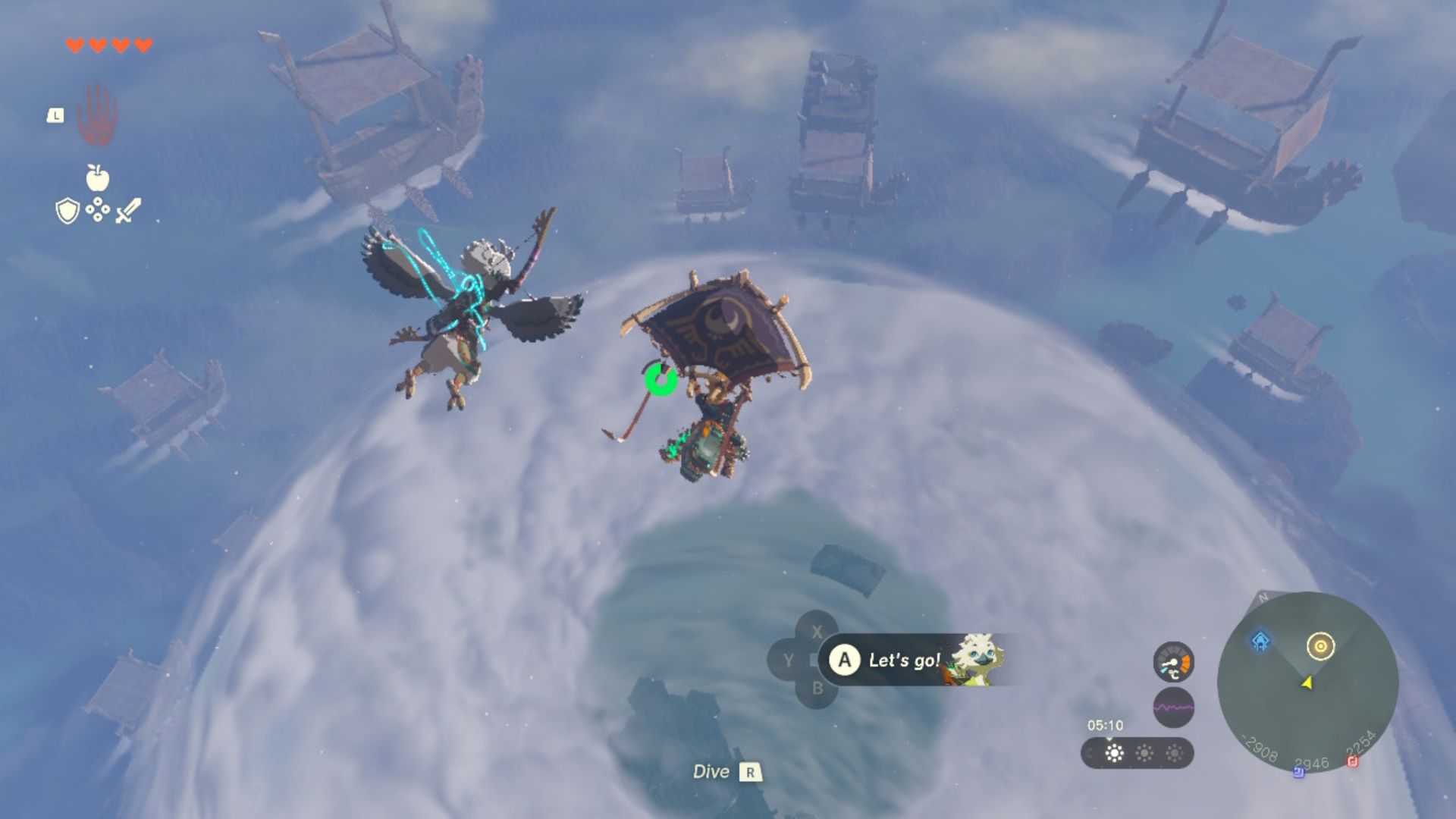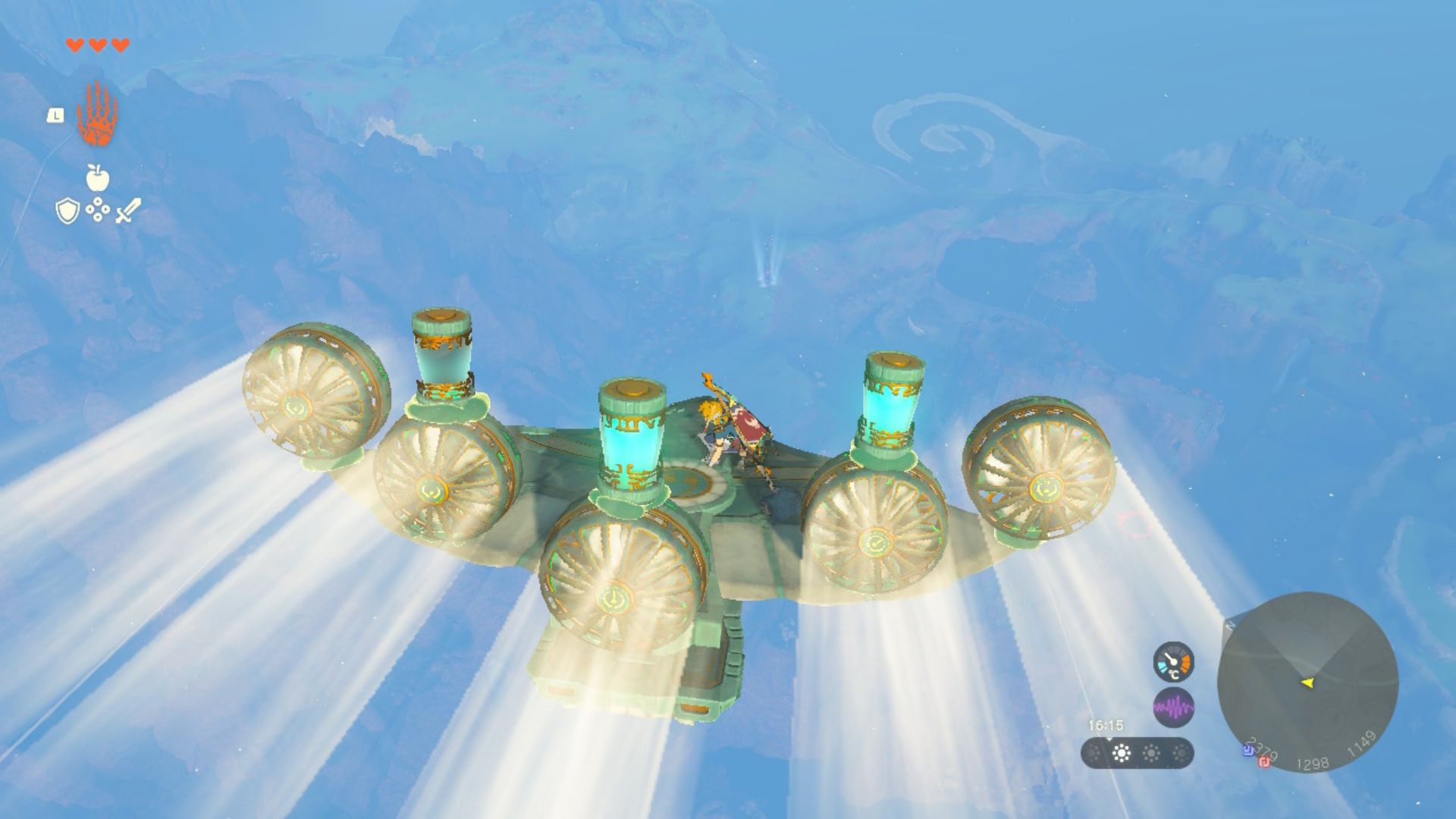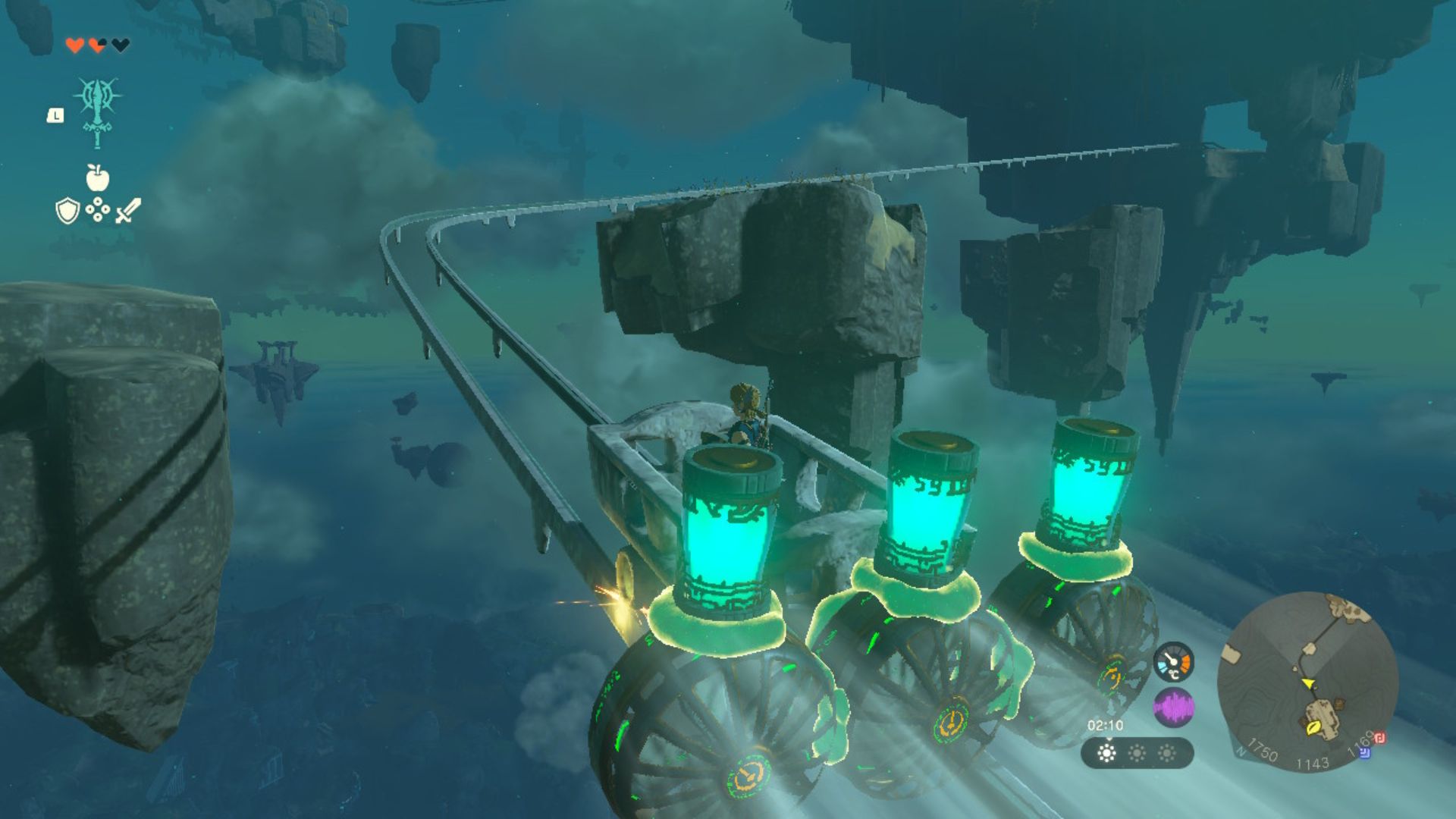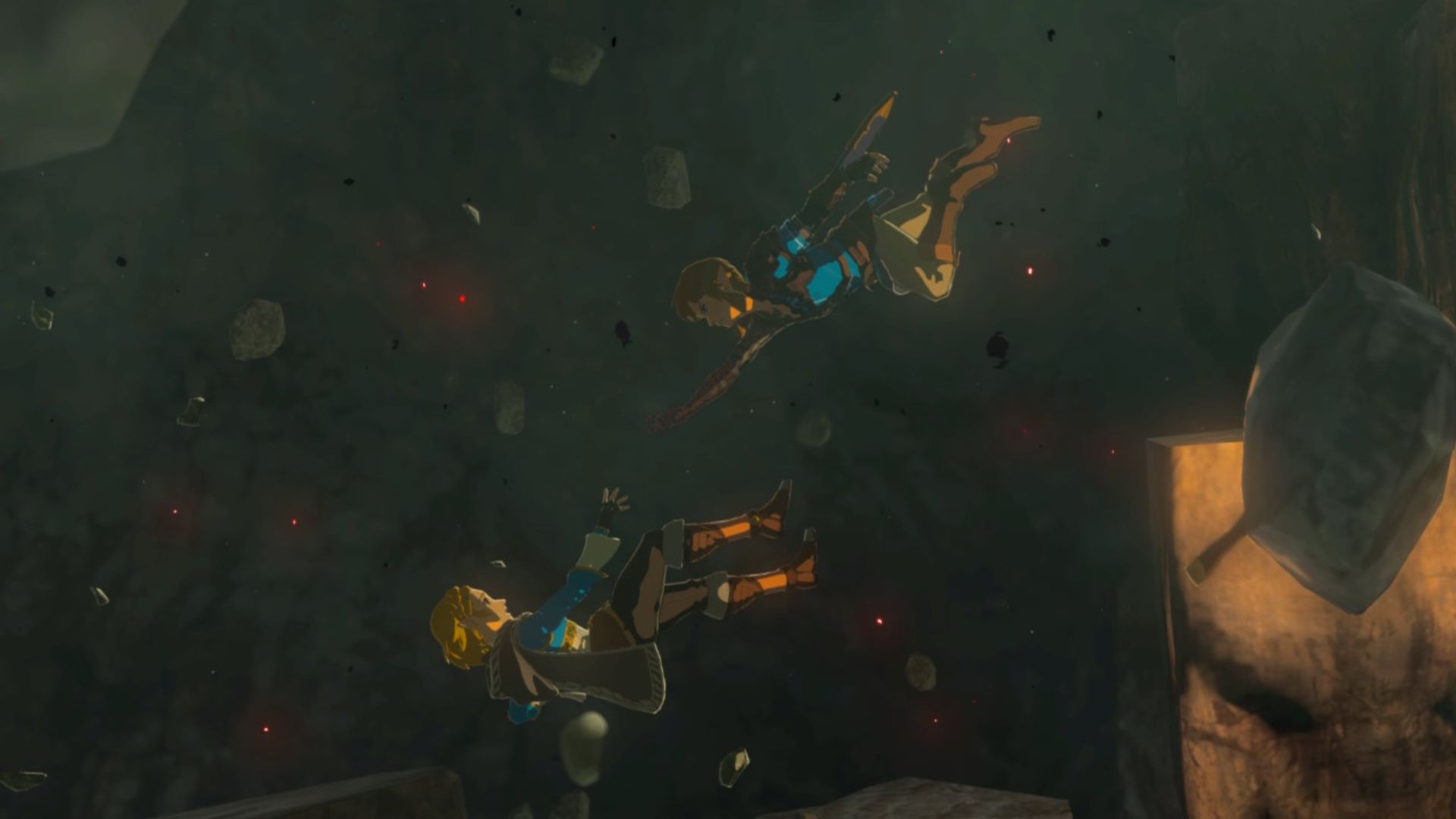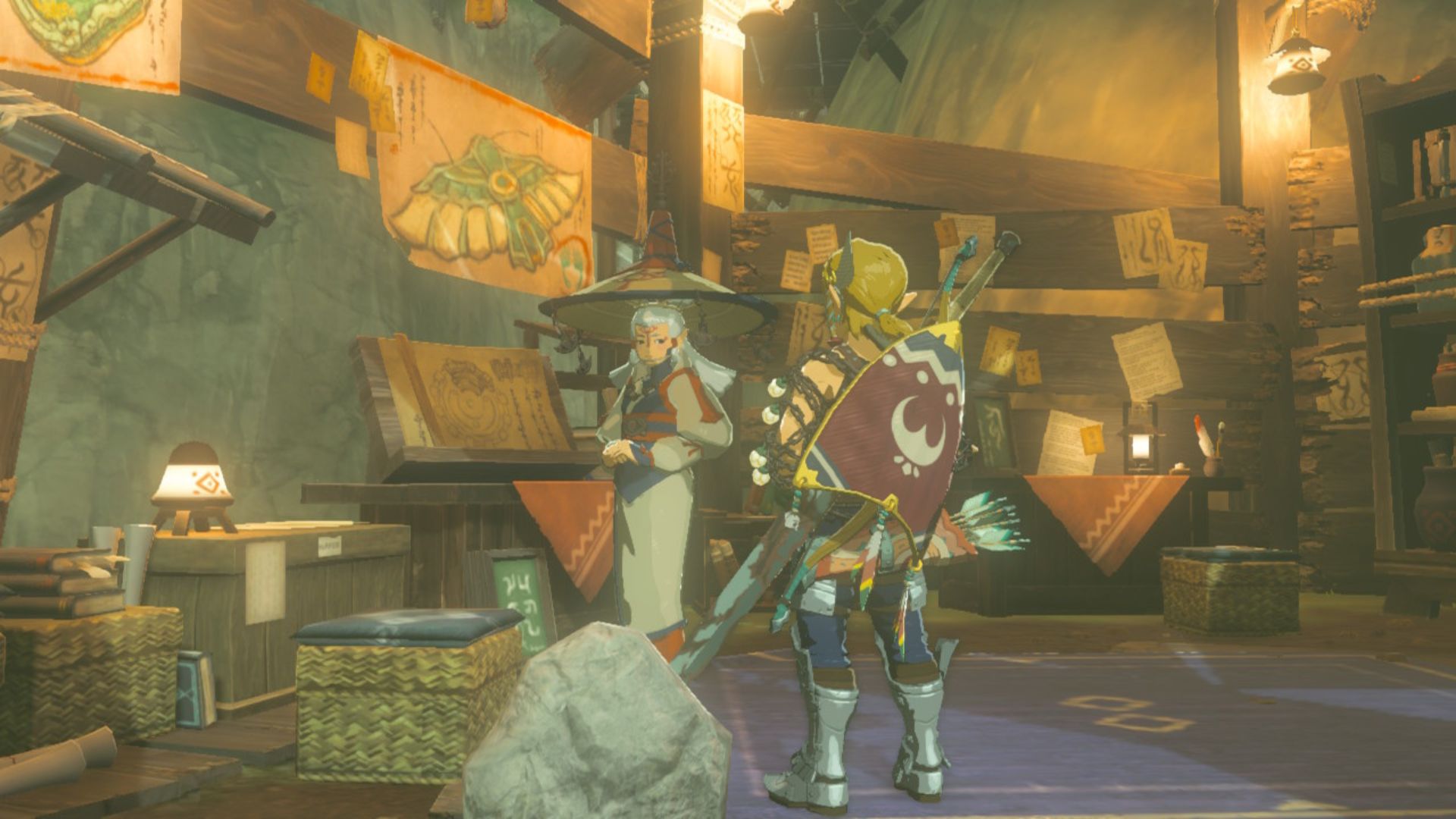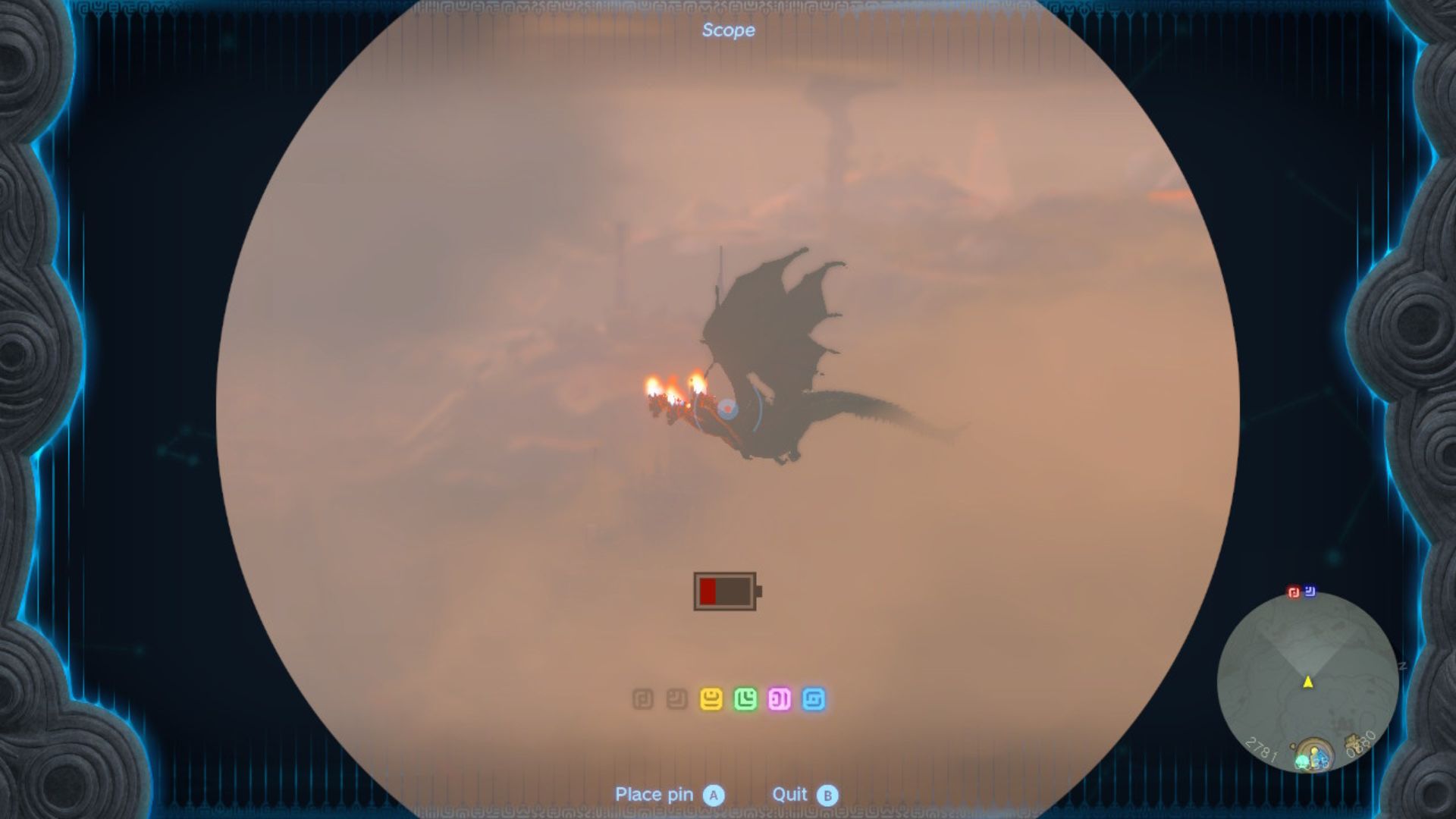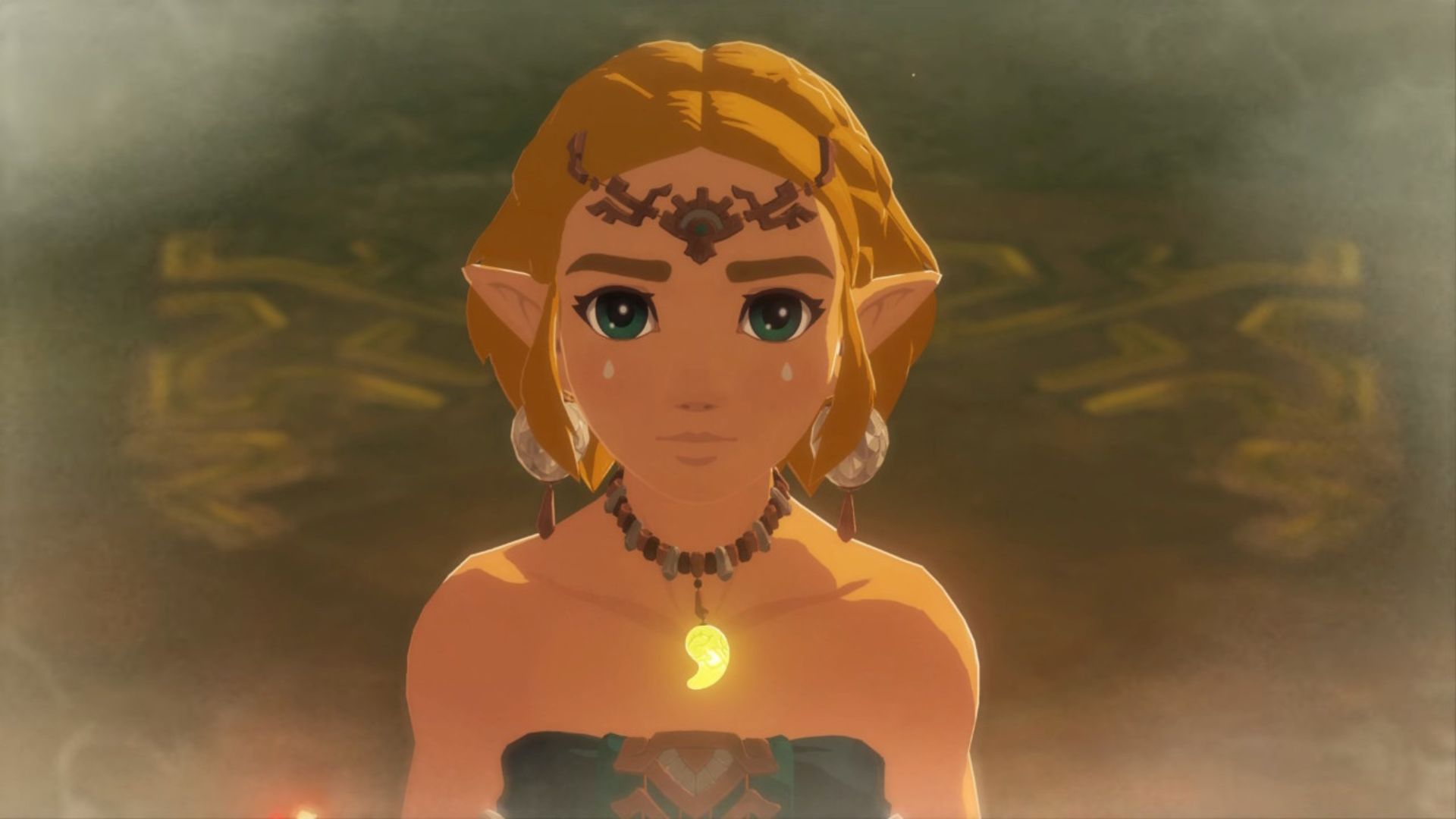Our Verdict
The Legend of Zelda: Tears of the Kingdom takes the magic of Breath of the Wild and makes it bigger, sillier, and much more fun. It’s an excellent time, packed to the brim with beauty and joy, and there’s nothing like it on the Switch.
The Legend of Zelda: Tears of the Kingdom knows it has big shoes to fill. Heck, everybody knows it. Breath of the Wild launched the Switch magnificently, topping a bunch of Best Games of All Time lists in the process. It’s open-world games and Zelda games at their zenith. It’s a tough thing to follow up.
So yeah, TotK has big shoes to fill. Big, big shoes. And it does the cleverest thing possible. It looks at Breath of the Wild and says, “I’m just gonna wear bigger shoes.” It’s Breath of the Wild in clown shoes designed by Gucci. It’s a heritage fashion house and a Swiss watchmaker working together on a spinning bow tie.
Tears of the Kingdom expands the world vertically in both directions, fills it with contraptions that whizz and whirr, and waits for you to arrive and make something happen. It takes you back to your parents’ house and says, “now it’s time to party.”
That doesn’t mean it’s all clown town, however. Booting up the game feels prestige-TV triple-A HBO-Last-of-Us fancy. Tiny letters give you “Nintendo Presents” on a plain black background before the game’s titles in exactly the same lettering leading you straight into a cutscene and onto the game. No menus, no logo; just quiet confidence.
Link is in some cave with Zelda, looking for ancient artifacts. The cutscene is long and slow and lovely, even a little bit funny. Then you take over, walking alongside Zelda at what feels like a glacial pace to anyone with BotW muscle memory. It feels like you’re playing an Assassin’s Creed, just walking along with an NPC with whom it’s impossible to match pace.
The premise is this: Zelda and Link find something underground, wake it up, the world goes topsy turvy, islands appear in the sky, Zelda falls into a crevice in the ground, and Link gets a new arm – that’s all sorted in around 30 minutes. From there, well, any story stuff is a spoiler. All that matters is this: you are Link, and you’re in the sky.

This prestige opening belies the game’s true vibe, something which becomes more and more apparent with every hour that passes. The first test is exploring the Great Sky Island, similar to BotW’s Great Plateau, but with added crevices, twistiness, and a whole lot more to do. The arrangement is the same, however – go to these shrines, pick up some powers, and then we can maybe work out what the heck is going on.
The powers are all brand new. Well, sort of. Ultrahand is like Magnesis except you can use it on most things. It lets you move stuff around, glue it together – that sort of thing. Fuse is fresher, giving you the power to fuse items to a weapon, or even weapons to a weapon. Recall is Stasis except it makes objects go backward as well as pausing time, while Ascend adds a whole new layer to traversal, letting you launch up through a ceiling or overhang and out the other side.
All four fundamentally change the focus of this game from its predecessor. Ultrahand lets you put stuff together, so now you can build 80ft bridges out of tree trunks to reach a destination. Or, once you’re a little further in, you can have a play around with the dozens of Zonai devices – from wheels and flamethrowers to bombs and cannons and all the way to Hooverless Roombas.
These different contraptions feel a little quaint at first. The puzzle could be to get across some water, and right next to you are some logs and a sail on a mast – simple. Later, you see three wheels and a plank of wood and wonder where the fourth is, or consider going for a build-your-own Reliant Robin. But much, much later – maybe 30 hours later – you’re considering how to make an automated robot with a faucet on its front to help turn lava into rock. You get silly and clown around.
But no matter how many rocket-fuelled, laser-firing, death-bent traction cities you build, you’re not gonna get to if-this-then-that levels of detail. Your contraptions will stay a little stupid, keeping comedy bubbling under every moment of free creativity. But because your contraptions are a bit thick, sometimes it’s best to jump off your rickety fortress and try to fight some enemies the old-fashioned way.
So, you get a sword. But uh oh! Because of all the bad stuff at the beginning, swords ain’t what they used to be, and neither are any of the other weapons out there. They’re all decaying. So, you want to make them last longer and pack a bigger punch, and, lucky for you, the mystical Great Sky Island has given you the exact tool for the job.
Fuse starts off as an excellently silly power for a few hours, before becoming weirdly banal and then changing again to a sort of happy medium. At first, it’s silly as heck. You put a chicken breast on the end of an arrow. You put a minecart on your shield. You put a giant boulder on the end of a wooden stick, so big that it has to shrink when Link holsters it on his back lest it clip through every object – clever that Fuse has that convenience tied in, eh?
After a while of seeing how quickly you can holster so much nonsense on Link’s back that he starts looking like a game of Buckaroo ready to buck, Fuse feels dry. The immediate combinations you make are just swords on the end of spears, spears on the end of spears, or some other combination of ‘weapon plus weapon equals long weapon’.
A little while later, however, it goes exactly the same way as Ultrahand and Zonai devices. You learn that rubies have the power of fire in them, Gerudo spears have a massive boost when fused, and a variety of other tiny rule changes that make combinations start to feel like a puzzle in and of themselves. A decayed traveler’s claymore has an attack of six, while my current strongest weapon in my inventory has an attack of 86, for example.
Recall and Ascend aren’t as deep, sure, but both powers reveal themselves as time goes on. In the first major story section, I spent hours climbing up something in the sky before realizing the game was shouting at me, “This is where we get you to remember to use Ascend later in the game.” Meanwhile, you can use Recall for all manner of magic tricks, so much so that it’s likely the best way to break the game – though I’m nowhere near understanding how (you can just use Ultrahand to move a thing to one place, then back, whip out Recall and hey presto, you’ve got a moving platform for Link to use, for example).
So, we have four powers laying the foundation for our activities. Now we’ve found them all, it’s time to skydive Fortnite-style down to Hyrule below and try and work out where Zelda is. Your best bet is to head straight for the central settlement, Lookout Landing, because that’s where the game tells you to go. Once there, you meet up with Purah and hear about some strange disturbances in four locations on the map. She recommends you go to the northwest corner first, to Rito Village. Oh, and she also gives you a paraglider.
So, it’s time to set off. You’re back in Hyrule and, wait a minute… it just feels like I’m playing Breath of the Wild again, except things look a little different. Well, just like its predecessor, TotK pulls tricks. This time, however, it has more expectations to play off of.
After the exciting intro on the Great Sky Island, Hyrule just feels a little empty, maybe just a little how it always was. Things are different, there’s stuff lurking that I could uncover, but minute to minute, walking around the place is just about how it used to be. And that’s because it is.
Your first bit of exploration triggers so many similar feelings to BotW. You learn about koroks, are introduced to a memory collection quest, and come across folks in need of saving from the monsters that litter the land. Oh, and shrines are back, and though they look different, they function the same – but this time with new powers, so that’s great fun.
This sets up TotK to really surprise you, however. This almost-underwhelming, tad-too-cozy start to your adventure suddenly turns to surprised, giddy delight thanks to the game’s obsession with going bigger.
There are two key surprises in the opening ten-or-so hours, beyond the Great Sky Island’s new and exciting powers. First off is the first main mission in Rito Village. After pottering about and meeting people (and learning that you need to keep warm in cold climates and vice versa), it’s time to go and find a big dungeon.
There’s a blizzard coating the village in snow, high up in the sky, so you and Rito kid Tulin head upwards. What starts off as a quaint few platforms with collectibles, enemies, and puzzles, soon develops into a massive gauntlet of death-drop platforming, bouncing around, and exploring. If memory serves, this section took me over an hour to complete – just to get the privilege of doing a dungeon.
This obstacle to the dungeon feels far more like Zelda than anything in BotW. It’s a little bit silly and gimmicky, but with just enough tightness that it never sags. Luckily, this goofiness is combined with the same keen eye for detail, both visually and physically, keeping everything luxurious as things get a little wacky.
Better yet, my actions feel almost automatic. I’m not wandering around, annoyed that I don’t know how to traverse this area in the best way possible from time to time. I just try something – stick a hot air balloon together and see how far I can go – and have a good time doing it. After a while, things get clearer, as you climb up a series of airborne trampolines right into the heart of the storm.
Once you dive into the blizzard you find the Wind Temple – a giant ship from Rito legend. You need to get inside it, but the gates are jammed. To get everything working there are five keys that Tulin can activate with his wind powers. These are hidden, either behind a pile of enemies, a simple puzzle, or just with tricksy placement. This is simpler than any of Breath of the Wild’s divine beasts, and it’s better for it. Gone is the fumbling about in a confusing 3D map trying to work out where the heck to go next. Things are more straightforward, making unlocking the Wind Temple a slicker prospect – and more rewarding than any divine beast in the process.
Once unlocked, it’s boss time, which also brings a welcome change in my opinion. Rather than a combat challenge with a Sheikah power involved, these are big and simple, just like the dungeon. They use powers you learned on the way to this boss, have clear targets, and feel massive. They are big, epic entertainment.
The other dungeons do vary slightly in quality, but this simple-yet–massive ethos is held over. My second temple in the northeast was a bit meh, but the third to the east and final in the southwest are just as enjoyable (I’m avoiding naming anything beyond the opening for any big spoiler-babies like myself).
Each temple completion grants you a new power – Tulin’s power of wind from the Wind Temple gives you a gust from behind which can help you soar through the sky for longer, for example. Using these powers is sometimes automatic (just tapping A while flying will trigger Tulin’s), but sometimes can be a bit more fiddly.
These new powers come from spirit versions of the heroes that help you in the dungeons. These spirits run or fly alongside you and help you take down enemies. Sometimes, to activate a power, you need to run up to this spirit and tap A to get them ready, then again to use the power. This is fiddly as heck, but luckily not too common an occurrence.
So, we go from familiar feeling shrines that offer up new challenges along a path that feels just like Hyrule of old, all the way to trampolining through the sky with our bird friend to try to infiltrate a flying ship shrouded in snow and littered with enemies and puzzles – all before taking down a giant boss that my conservative estimate puts at a gazillion times bigger than little Link. That’s the first trick TotK pulls – you feel like you’re playing Breath of the Wild until you’re most definitely not. But I did say there are two TotK tricks.
The second trick it pulls is slowly developing a new way of traversal: the sky. While on my way to Rito Village, I frequently felt at home. I see something shine in the distance or have a hill in my way, and so I have a goal. The hill is blocking my view of what’s next, so I better climb it. Once there, I see a shiny thing and go towards it. On the way I get distracted by other gubbins and before you know it the world feels massive again.
But after the Wind Temple, I realized one key thing – Link is now obsessed with sky-diving, for some reason. So, if this really is a role-playing game, I better put myself in his shoes and get up into the sky to give this kid the kick he so craves, right? Well, yeah, that’s what I did. And that’s now what I do.
Rather than a slow trudge up a hill or round treacherous mountains, Tears of the Kingdom is constantly tempting you to go upwards in a straight line. Rocks fall from the sky just begging to have Recall cast on them. You could hop on and find they lead to nothing interesting, but now you’ve got a free paraglide ride across Hyrule with a clear view of all the other points of interest out there.
The Sheikah Towers of BotW have also been changed for the better. Not only are there lovely little puzzles to unlock them, but you also don’t have to climb anything — this time they’re launchpads. Sure, they function the same way, giving you a map of Hyrule. But Link needs to map the sky islands too, of course. So, the towers launch you in the air, Link holding his trusty, stony Nintendo Switch (Purah Pad) to scan all below.
These launches usually occur right next to a string of sky islands that offer a pleasantly formulaic challenge. There are some chests with treasure maps and other key collectibles, a few enemies, a shrine, one massive gashapon machine that plops out Zonai devices, and an excellently inventive boss known as a fusion construct.
These sky archipelagos become predictable in the best way possible. You run along thinking, ‘There has got to be a treasure map here because all the others have one,’ before finding it in a clever new hiding spot. Or these fusion constructs turn from straightforward fights to massively finicky puzzles after a short island hop. Expectations of repetition get broken interestingly.
At first, it looks like the sky islands are sparse. They barely take up any space in the sky compared to the Great Sky Island. But every archipelago is dense with stuff, the direct opposite of the surface’s quiet, lonely discovery. Both are wonderful, but a short hop along an archipelago gives a quick fix.
So, we’re in the sky, which means we can fly across the map in any direction we want. This means we don’t have to spend all that much time plodding around Hyrule thinking about how beautiful it all is. At first, I was worried I was playing the game wrong – I wasn’t seeing much of the surface.
Now, after so many hours, however, I’m just so excited. There’s still so much I haven’t seen. I haven’t taken the long road through Gerudo Canyon to Gerudo Town – I just flew to a tower nearby and launched myself from there to the town. Now, when I get my head out of the clouds, I have all that to look forward to. I’m going to build a monster truck for the dunes. I’m going to have so much fun.
And this is what it’s all about: fun. This breakdown of the different systems, traversal methods, dungeons, and story stuff doesn’t really convey anything other than what this game is on paper. In reality, it’s a million times greater than the sum of its parts.
Early on, I fall down a well. Everything is dark – I haven’t done a quest that introduced me to what was going on – and I find an enemy. This enemy is far too difficult and I die. It took me hours to work out what’s going on down there and it’s an absolute treat.
Later, while trying to cross some water with a glowing green stone to give it to a shrine so it could give me some goodies, I get stuck. My makeshift hovercraft capsizes. I decide to turn it into a paddle steamer. My paddle steamer doesn’t work at all. I watch it flopping around in circles, churning up water, and it’s hilarious.
After that, I go back to the town where I got this rock from. The same beautiful music is playing as in Breath of the Wild, and I feel right at home. Someone’s little Gerudo kid needs to make the journey over to Gerudo Town without her parents, as is tradition, and Link is tasked with helping her father come to terms with that. In a cartoony-as-heck way, sure, but in a really sweet way, too.
About 25 hours prior to that, I jump off a sky island and straight down. I land next to a Moblin by a well, but I’m on a platform above it, so it chooses to throw rocks at me. While trying to shoot it with an arrow, I accidentally hit one of the incoming rocks, knocking my arrow to my feet and redirecting the rock straight into the Moblin’s face.
The world of Tears of the Kingdom is just like Breath of the Wild but more – turned up louder, made better at facilitating the player. So, you just do stuff with things. You do things with stuff. Action results in a reaction. Plans lead to something that makes sense in-world. Maybe not what you planned, but definitely because of what you did. Everything is your fault. Every decision is your joy.
To help facilitate these endless anecdotes, there’s lots beyond the nonsense. The main story is a bit more of a key player here, but it’s still definitely some Zelda. Then the side quests range from simple blips to longer moments that focus on characters. Meanwhile, cities and towns feel livelier than BotW, and the new Zonai devices that litter the landscape can sometimes crop up here, showing us rollercoasters or ferries designed by the townsfolk, something cutely playful.
There are more enemies too – filling likely the biggest criticism (beyond the asinine weapon durability one) of BotW. There are big boss Bokoblins who lead a pack of little fellas in formation, flying pests that launch themselves at you in a thrilling dogfight as you fly through the sky, and massive, three-headed beasts that I’m still too scared to fight.
All these new aspects mesh brilliantly with the countless systems already in TotK’s predecessor. Cooking is still here, as are temperature changes. It has everything from BotW that we’re so used to and builds on top of it instead of reinventing it. Combine all this with the endless, deep caves in the walls of hills and mountains and the sheer amount to do in Tears of the Kingdom can be overwhelming. You can mine through a cave system for forty minutes if you want to. You can delve deeper into Tears of the Kingdom than its predecessor, metaphorically and literally.
One aspect that is sadly similar to BotW is the performance – though this is no surprise given the six-year-old Switch. Dense foliage and clever lighting can bring the framerate down to what feels like single figures, while pop-in naturally plagues the swiftest descents from the sky. This is fine and doesn’t dramatically hinder any aspect of the game – but it would be much nicer at 4K 60, wouldn’t it?
The reason it would be so much nicer at 4K 60 is because this game is so, so beautiful. While it may be full of hilarious junk to play around with, the silliness is frequently penetrated with serene beauty; hot-footed frogs and bright-eyed crabs scurrying up a waterfall of stairs towards a mountain peak, a slow balloon ride through the sky with no specific destination as the sun sets.
This beauty applies just as keenly to the music. The delicate shyness of twinkling piano and rare strings feels familiar on the surface, but the melodies in the sky reflect our newfound playfulness. Leap from an island for a skydive and the music sounds bigger than any other exploration moment, imbued with a sense of discovery, helping you feel like you’re really going on an adventure.
This attention to detail is littered all over Tears of the Kingdom, as anyone who knows Breath of the Wild would expect. But it never gets in the way of fun. Every inch of Tears of the Kingdom is a tentative elbow in the right direction, a direction that usually leads to wacky paddle steam flops into the sea or wonky hot air balloon Hindenbergs-in-the-making.
So, Tears of the Kingdom may have big shoes to fill. But none of that matters once you start playing – I imagine a lot of folks will never be able to return to BotW with the same joy after touching TotK. Still, I assume some people are going to be less enamored by this sequel – it looks the same as BotW, the controls are the same, and maybe foundationally it’s pretty darn similar. But it’s like going back to a restaurant that has a rotating seasonal menu – and this time around everything is in season. Tears of the Kingdom is everything plus the kitchen sink plus fifty other things you didn’t realize you needed. It is indiscriminate with its ability to shove fun into every corner.
And all that is really quite hard to explain without someone getting their hands on it. Can the sequel to one of the best games ever get the same plaudits? Probably not. It’s still a party at your parent’s house, after all. But none of that really matters. I’ve never had this much fun with my Switch. Not even with Breath of the Wild, the first game I ever wrote anything about, the reason I’m here writing this now. The Legend of Zelda: Tears of the Kingdom is the best game on Nintendo Switch, a masterpiece of open-world sandbox design, and the best game in the series, at least in my books — it just feels more Zelda. It’s just overflowing with fun. It is Breath of the Wild: The Videogame. It’s a Gucci spinning bowtie that some folks are gonna be too embarrassed to wear with pride. Not me.
The Legend of Zelda: Tears of the Kingdom is out now for Nintendo Switch.
For more check out our Zelda: Tears of the Kingdom enemies, Zelda: Tears of the Kingdom Zonai, Zelda: Tears of the Kingdom fusion, and Zelda: Tears of the Kingdom vehicles.
